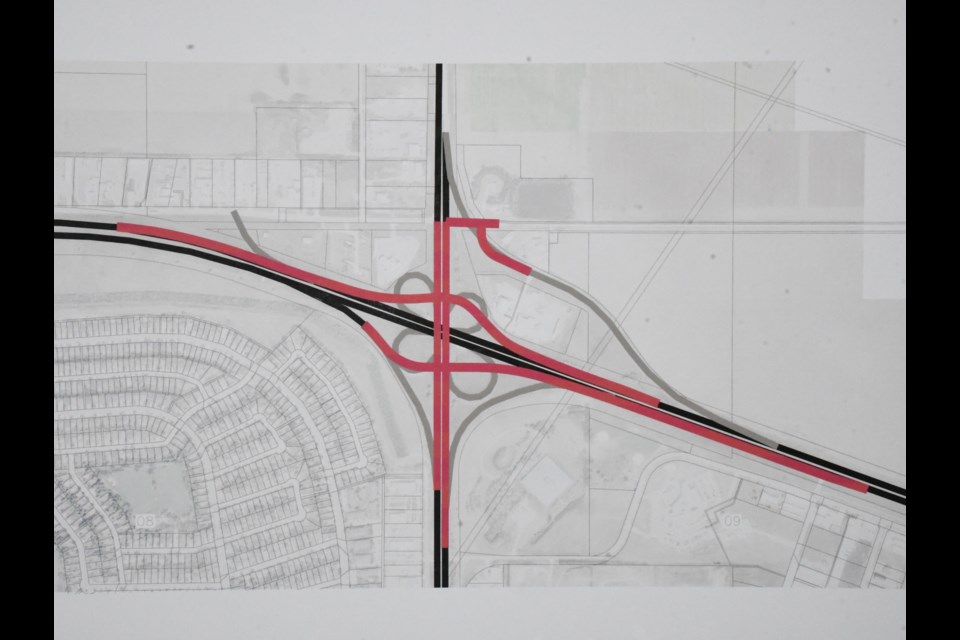MOOSE JAW — The Highway 1 overpass bridge will look much different in two years, as the familiar cloverleaf will disappear and the structure itself will be raised to accommodate oversized loads.
The $33.7 million, provincially funded project will demolish the existing pair of Highway 2/Main Street North bridges — they are nearly 60 years old — that are 4.5 metres in height. Contractors will then raise the bridges’ height to 5.3 metres.
Furthermore, the existing cloverleaf-shaped on- and off-ramps will be replaced with modern diamond-shaped on- and off-ramps, similar to the Regina Bypass network.
A Ministry of Highways contractor should begin demolishing the northbound bridge around April 1. The contractor is expected to move more than 130,000 cubic metres of earth, equivalent to 35 Olympic-sized swimming pools.
During construction this year, Highway 2 will have two-way traffic on the southbound bridge while contractors build the new northbound bridge. Next year, Highway 2 will have two-way traffic on the new northbound bridge while contractors build the new southbound bridge.
Meanwhile, Highway 1 will be reduced to two-way traffic, while traffic from the exit ramps will be detoured as needed.
The ministry held a news conference at its shop on the North Service Road on March 28 to announce the project, with more than 40 people — local politicians, city council, city administration, RM of Moose Jaw, Moose Jaw Police Service, Chamber of Commerce, and other provincial groups — in attendance.
Mayor James Murdock said he was “ecstatic” about this project, while this announcement was “a great day” for Moose Jaw, its residents, Saskatchewan motorists and anyone who visits the community.
“This is a momentous day, and this basically is all about safety for individuals,” he continued. “Some may say that this is long … overdue, but we’re very appreciative for the support we’re getting from the provincial government in making this commitment.”
The community is usually abuzz after a semi-truck hits the overpass because these incidents have occurred “again (and) again and again” for decades, the mayor said. So, he hoped this project would put those concerns to rest permanently.
Raising the bridges’ height will provide the trucking industry with more peace of mind since truckers “are the lifeline” of the economy, Murdock added.
A project of this magnitude cannot be completed in one year because of several factors, said MLA David Marit, the minister of highways. Those factors include changing the area’s design, moving almost 130,000 cubic metres of earth, raising the bridges and paving the roads after construction before frost hits.
“So obviously the biggest concern we have is public safety and making sure that everybody respects the zone and reduces speed,” he stated.
The cloverleafs are disappearing because businesses on the North Service Road prevent contractors from making the loops bigger, the minister noted. Removing the loops will make the area safer, while the trucking industry appreciates the diamond shape better.
This new design will make the bridge infrastructure over Highway 1 more consistent across Saskatchewan and Canada, Marit continued, while he agreed that this project brought the transportation system “to a whole new level” since it improved the economic flow of goods.
The minister added that this project may delay the ministry’s efforts to address the intersection at Ninth Avenue Northwest and Highway 1, since it would wait for this initiative to conclude before rolling out any changes to that area.
George Henderson, the director of operations and member services with the Saskatchewan Trucking Association, said this project was a “critical improvement” that would enhance safety for the 1,000 truckers who use this “key transportation corridor” daily.
Henderson added that this improvement would help reduce provincial trade barriers and potentially counteract tariffs from the United States.




